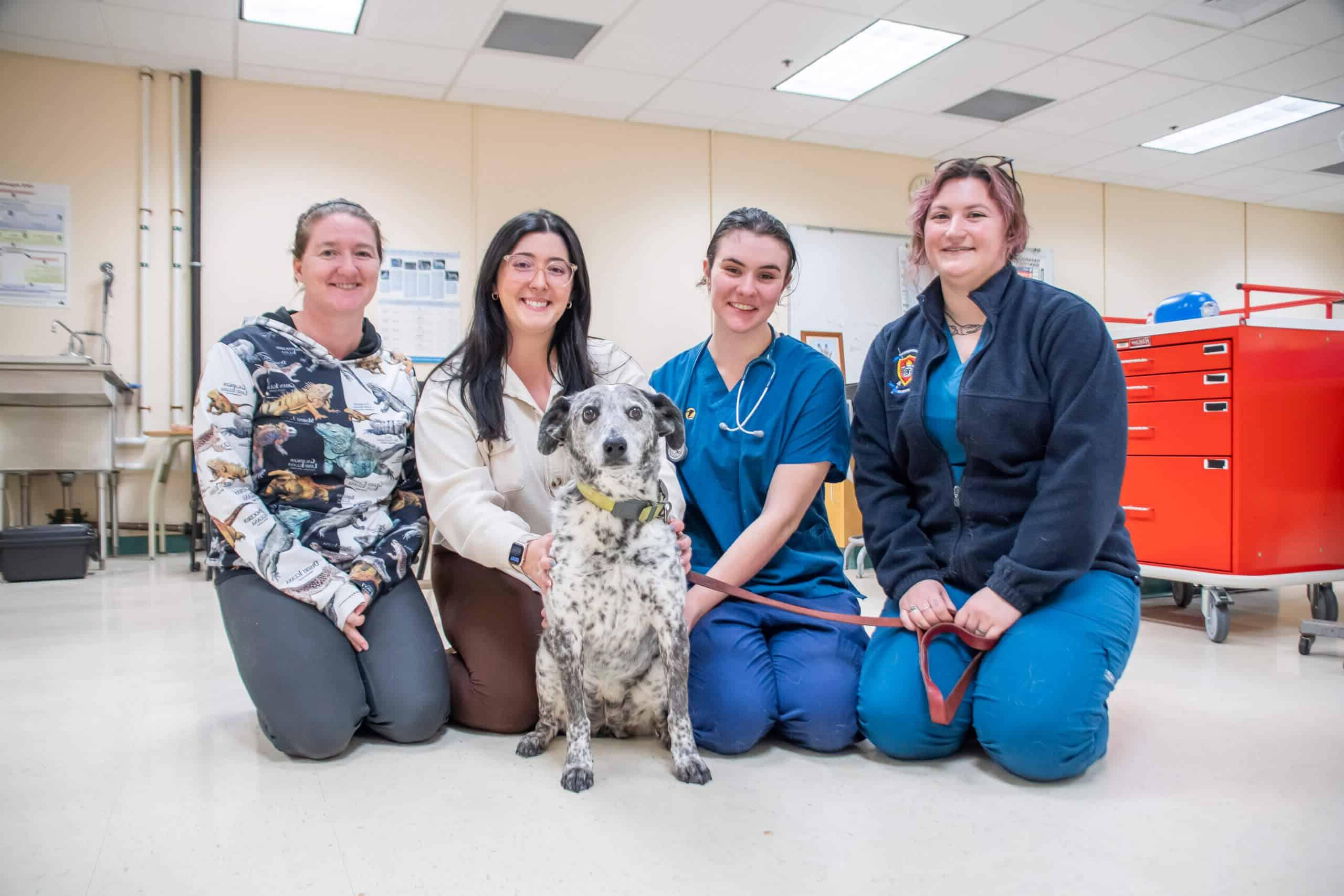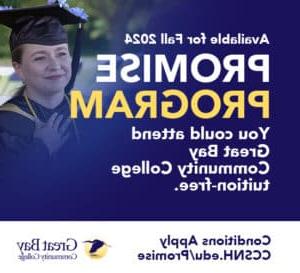Overview
What is a Veterinary Technician?
Are you interested in health care but also have a passion for animals? As a veterinary technician, you work on a team of veterinary professionals to provide healthcare for animals. Using classroom work, labs and clinical experiences, the Veterinary Technology program at GBCC provides you with the academic background and skills needed to work hand in hand with the veterinarian.
Graduates are eligible to become credentialed veterinary technicians (VTNE information) and to work in veterinary practices or other veterinary related fields.
Why Great Bay?
- The Veterinary Technology program is well established in both our academics and in the veterinary community.
- The program has maintained full accreditation with the AVMA since 1998.
- Our course offerings change to reflect the profession’s evolution. Veterinary Technology courses are all taught by veterinarians or technicians who have worked and are experienced in the field.
In-Depth Description
As the field of veterinary medicine becomes increasingly complex, there is a growing need for skilled, educated paraprofessionals who can perform a variety of duties. Veterinary technicians work as a team with veterinarians providing medical, surgical, and laboratory procedures. They offer comprehensive support to clients as well as general healthcare to the animal patient.
The Veterinary Technology program is accredited by the American Veterinary Medical Association (AVMA). The program provides education in the basic sciences and liberal arts as well as in veterinary technology. Program only starts in the fall semester.
Hands-on experience is obtained during clinical affiliations at local animal hospitals, service- learning sites, and spay/neuter clinics. Transportation to and from the clinical site is the responsibility of the student. Clinical Affiliation experiences may vary in time and in locations including days, evenings, and/or weekends. Students are required to purchase, through the college approved vendor, a scrub top and bottom, and a lab coat in their first semester in the program. Scrubs will be worn in lab courses at the college and during clinical affiliations. Lab coats will be worn in anatomy and clinical pathology lab courses. Veterinary courses including Veterinary Anatomy and Physiology I and II must be successfully completed with a minimum grade of C+ before enrollment in the subsequent semesters, Clinical Affiliations, and to graduate from the program.
The goal of the program is to provide our students with a comprehensive academic foundation emphasizing technical skills, integrity, and professionalism. The program may be completed on a full-time or part-time basis. All veterinary technology courses must be completed within four years of the date of entry to the program. Students admitted to or re-entering the program must meet current requirements necessary for graduation.
Successful completion of this degree program provides students the opportunity to seek employment in veterinary hospitals and other veterinary related fields. Graduates may find jobs in veterinary hospitals, medical laboratories, pet-related industries, zoos, research facilities, and the pharmaceutical industry. They are also eligible to take the Veterinary Technician National Exam (VTNE) to become certified or licensed. Pass rates for Veterinary Technology Degree recipients can be found below.
Veterinary Technician National Exam (VTNE)
Graduates are eligible to sit for the VTNE to become a credentialed veterinary technician. For more information on the exam click here.
GBCC offers a review course for GBCC graduates and graduates of other accredited vet tech programs to prepare for the VTNE.
Highlights
Pass rates for Veterinary Technology Degree recipients, for July 1, 2021 – June 30, 2024, are presented below.
| Number of first-time candidates that have taken the VTNE | 59 |
| Three-year VTNE pass percentage | 66.1% |
Career Options
Successful completion of this degree program provides students the opportunity to seek employment in veterinary hospitals and other related fields. Graduates most often find jobs in veterinary hospitals but also can find jobs in medical laboratories, pet-related industries, zoos, research facilities, and the pharmaceutical industry. They are eligible to take the Veterinary Technician National Exam (VTNE) to become certified or licensed.
To learn more about potential earnings visit:
- Bureau of Labor Statistics Occupational Outlook Handbook
- National Association of Veterinary Technicians in America
- American Veterinary Medical Association
- American Association for Laboratory Animal Science
Related Degrees
First Year – Fall Semester
| Course ID | Course | Theory | Lab | Credits |
|---|---|---|---|---|
| VETN110G | Introduction to Veterinary Technology | 2 | 0 | 2 |
| BIOL111G | Veterinary Anatomy and Physiology I | 3 | 3 | 4 |
| ENGL110G/ 111G | College Composition I / College Comp I with Lab | 4 | 0/2 | 4/5 |
| MATH145G | Quantitative Reasoning | 4 | 0 | 4 |
| or | ||||
| MATH147G | Quantitative Reasoning Plus | 5 | 0 | 5 |
| ***Students will enroll in one of these Math courses depending on Accuplacer testing or previous course work. | ||||
| Total Credits | 14-16 | |||
First Year – Spring Semester
| Course ID | Course | Theory | Lab | Credits |
|---|---|---|---|---|
| VETN121G | Veterinary Clinical Methods I | 3 | 3 | 4 |
| BIOL121G | Veterinary A&P II | 3 | 3 | 4 |
| VETN114G | Veterinary Pharmacology | 2 | 2 | 3 |
| VETN115G | Veterinary Parasitology | 2 | 0 | 2 |
| CHEM110G* | Introduction to Chemistry | 3 | 3 | 4 |
| *Students planning on transfer to a four-year college may substitute CHEM115G | ||||
| Total Credits | 17 | |||
Summer Semester
| Course ID | Course | Theory | Lab | Credits |
|---|---|---|---|---|
| VETN130G | Veterinary Clinical Affiliation I | 0 | 24 | 4 |
| VETN225G | Veterinary Practice Law | 2 | 0 | 2 |
| or | ||||
| VETN226G | Small Animal Behavior | 2 | 0 | 2 |
| or | ||||
| VETN227G | Veterinary Emergency Medicine | 2 | 0 | 2 |
| **Students must choose from one of the three VETN elective courses offered. | ||||
| Total Credits | 6 | |||
Second Year – Fall Semester
| Course ID | Course | Theory | Lab | Credits |
|---|---|---|---|---|
| VETN210G | Veterinary Clinical Methods II | 3 | 3 | 4 |
| VETN212G | Laboratory Animal Science | 2 | 2 | 3 |
| VETN215G | Large Animal Management | 2 | 2 | 3 |
| VETN220G | Veterinary Clinical Pathology I | 2 | 3 | 3 |
| VETN214G | Veterinary Pharmacology II | 1 | 0 | 1 |
| Social Science Elective | 3 | 0 | 3-4 | |
| Total Credits | 17-18 | |||
Second Year – Spring Semester
| Course ID | Course | Theory | Lab | Credits |
|---|---|---|---|---|
| VETN221G | Veterinary Clinical Pathology II | 2 | 3 | 3 |
| VETN224G | Veterinary Diagnostic Imaging | 1 | 3 | 2 |
| VETN222G | Veterinary Clinical Affiliation II | 0 | 12 | 4 |
| Foreign Language/Humanities/Fine Arts Elective | 3 | 0 | 3 | |
| VETN223G | Veterinary Technician National Examination (VTNE) Preparation | 2 | 0 | 2 |
| Total Credits | 14 | |||
| Total Overall Credits: 67-70 | ||||
Curriculum Recommendations
Students are encouraged to take the required program general education courses before they begin the Veterinary Technology program. Alternatively, they should take the general education courses as they appear in the recommended sequence above. If a student fails to complete a first-year general education course, they are encouraged to take it over the summer between first and second year along with their Clinical Affiliation I and VETN elective course. The student may not take the credentialing exam (VTNE) until all courses are complete and the student has graduated. Health insurance is recommended for the entirety of the program.
Accreditation Information
The Veterinary Technology program is accredited by the American Veterinary Medical Association (AVMA).
The AVMA Committee on Veterinary Technician Education and Activities (CVTEA) accredits veterinary technology programs. All AVMA CVTEA-accredited programs in veterinary technology must meet the Standards of Accreditation of the CVTEA to ensure the quality of the educational experience and the assessment of student knowledge and skills.
Clinical Requirements
Prior to participating in required service learning for VETN121G, students must:
- Possess and maintain health insurance and professional liability insurance. (Professional liability insurance is available at the College.)
- Have documentation showing current rabies, tetanus, measles, mumps and rubella vaccinations.
- Provide proof of a negative TB skin test.
Prior to the first clinical affiliation, students must also:
- Purchase a radiology dosimeter badge (available at the College).
Technical Standards
The program is physically strenuous requiring lifting animals up to 50 lbs. and working with large animals. Sufficient manual dexterity and vision is necessary to perform clinical and microscopic procedures. Students will be expected to establish priorities, function effectively in emergency situations, comply with safety regulations, and communicate in a professional manner during clinical affiliations. Individuals who cannot meet these standards may have difficulty satisfying course objectives and becoming successful as a Veterinary Technician.
Admissions Criteria
The deadline for completion of the application process, including the interview with the director, is April 30th. Early decision is possible for applicants with a strong academic history who complete their application prior to the deadline.
Admissions Requirements
- Complete an application to the program.
- Provide proof of high school completion or equivalent.
- Provide proof of completion of high school algebra, biology, and chemistry or equivalent of current enrollment.
- Place into college level Math, Reading and Writing or demonstrate equivalent competencies through a college transcript or SAT scores.
- Complete a personal interview with the program director.
Applicants will be contacted by Admissions to set up interviews with the program director once the first four requirements have been met.
Additional Information
Veterinary Technology Program Suspension Information and Readmission Policy
Students matriculated in the Veterinary Technology program who withdraw or do not achieve the minimum grade in the Veterinary Technology or Veterinary Anatomy and Physiology I and II courses will be allowed to retake the course/s one time only. Should a student fail to achieve the minimum grade on the second attempt, they will be dismissed from the program and must re-apply if they choose. Students who have failed a Veterinary Technology course because of unsafe practice involving actions or non-actions are dismissed and not eligible for readmission to the Veterinary Technology Program.
Advanced Placement
Admission to the program for students transferring from another AVMA accredited Veterinary Technology program will be determined by the program director based upon courses that have been successfully completed and space availability. All students seeking advanced placement are subject to the same admission and program requirements.
Transfer Credit Policy
In addition to Great Bay Community College transfer credit policies, there is a ten year limitation on accepting the course equivalencies of all VETN courses, BIOL111G and BIOL121G. Exceptions may be made by the department chairperson.
Program Outcomes
The goal of the program is to provide our students with a comprehensive academic foundation emphasizing technical skills, integrity, and professionalism. Based on curriculum standards set by the American Veterinary Medical Association, the program partners with New England veterinary facilities to create skilled medical professionals qualified for employment in many areas of the veterinary healthcare field.






